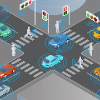The recent advances aiming to enable in-network service provisioning are empowering a plethora of smart infrastructure developments, including smart cities, and intelligent transportation systems. Although edge computing in conjunction with roadside units appears as a promising technology for proximate service computations, the rising demands for ubiquitous computing and ultra-low latency requirements from consumer vehicles are challenging the adoption of intelligent transportation systems. Vehicular fog computing which extends the fog computing paradigm in vehicular networks by utilizing either parked or moving vehicles for computations has the potential to further reduce the computation offloading transmission costs. Therefore, with a precise objective of reducing latency and delivering proximate service computations, we integrated vehicular fog computing with roadside edge computing and proposed a four-layer framework named FoggyEdge. The FoggyEdge framework is built at the top of named data networking and employs microservices to perform in-network computations and offloading. A real-world SUMO-based preliminary performance comparison validates FoggyEdge effectiveness. Finally, a few future research directions on incentive mechanisms, security and privacy, optimal vehicular fog location, and load-balancing are summarized.
翻译:最近的技术发展旨在实现网络服务提供,从而支持大量的智能基础设施发展,包括智慧城市和智能交通系统。边缘计算与路边单位相结合,出现了作为近距离服务计算的有前途的技术,但由消费车辆对全面计算和极低延迟需求的不断上升正在挑战着智能交通系统的推广。利用停泊或移动车辆进行计算的车载雾计算,有潜力进一步降低计算卸载传输成本。因此,为了降低延迟并提供近距离计算服务,我们将车载雾计算与路边边缘计算相结合,提出了一种名为“FoggyEdge”的四层框架。 FoggyEdge框架建立在命名数据网络之上,利用微服务进行网络计算和卸载。使用基于实际世界的SUMO的初步性能比较证实了FoggyEdge的有效性,最后总结了一些未来的研究方向,如激励机制、安全和隐私、最优车载雾位置和负载平衡。



